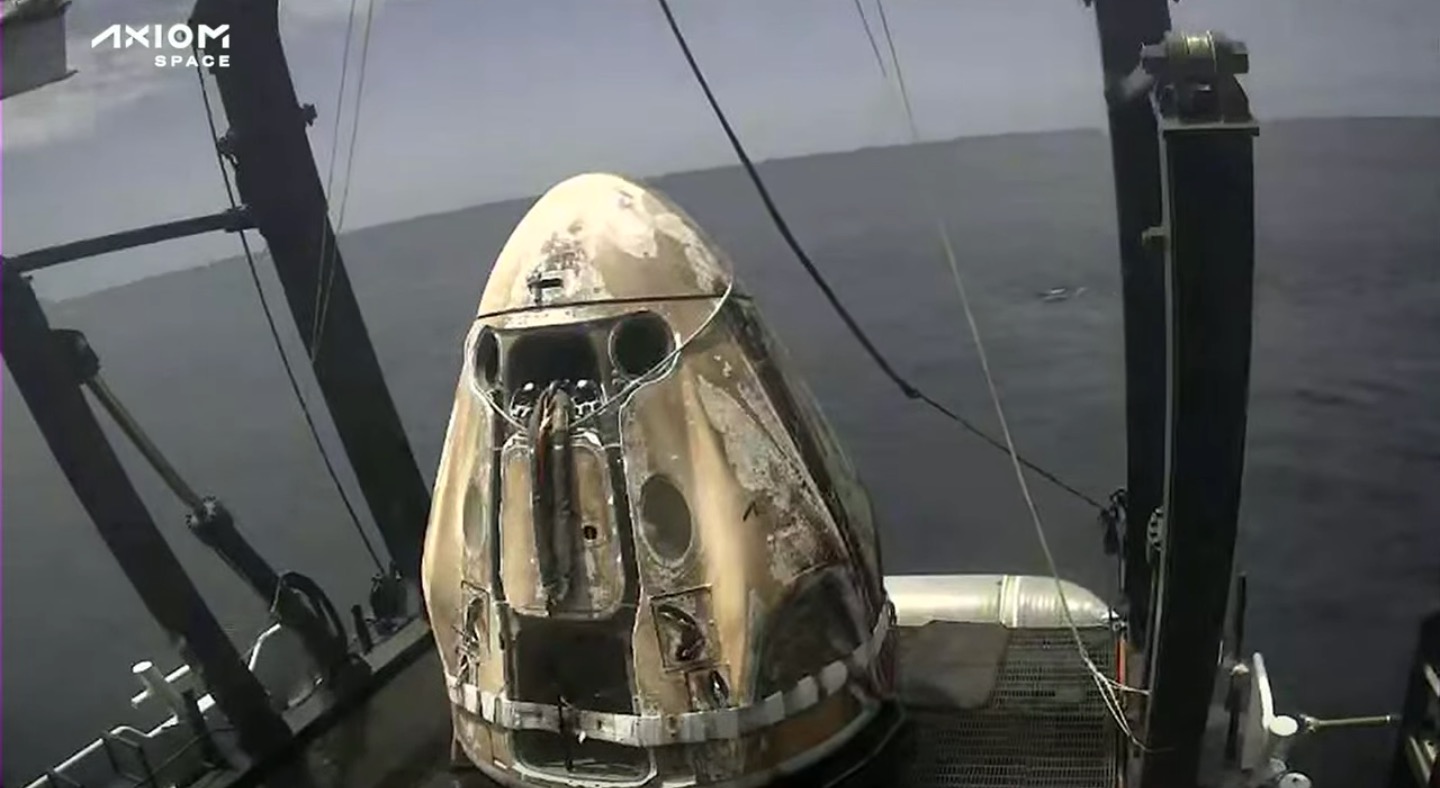NASA denies claim of dangerous heat shield issue during SpaceX's Ax-1 mission
There was no leak of propellant into the spacecraft's heat shield, NASA said.

On April 8, SpaceX launched Axiom 1 (Ax-1), the first-ever all-private crewed mission to the International Space Station (ISS).
Ax-1 ferried four passengers to the ISS, where they and their Dragon spacecraft remained for more than two weeks. That Dragon, a vehicle named Endeavour, returned to Earth on April 25, splashing down off the coast of Jacksonville, Florida, where it and its crew were safely recovered.
In an article published on Monday (May 23), the website Space Explored alleged that Endeavour experienced an issue during its mission that could have had disastrous consequences during last month's homecoming.
Related: Amazing photos of SpaceX's Ax-1 private astronaut mission
The Space Explored report, citing unnamed sources at NASA and SpaceX, claims that hypergolic propellant — fuels paired to instantly combust on contact — leaked into Endeavour's heat shield during the mission. (Dragon's Draco thrusters use hypergolic propellants.)
"It is believed that this hypergolic propellant impacted the integrity of the heat shield, causing dangerously excessive wear upon reentry," Space Explored wrote. The report goes on to speculate that SpaceX's Crew-4 mission for NASA, which launched toward the ISS on April 27, could suffer a similar issue when it heads home this September.
But NASA says that such fears are unfounded. The agency has issued a statement refuting the heat shield claims, which Space Explored included in an update of the article.
Get the Space.com Newsletter
Breaking space news, the latest updates on rocket launches, skywatching events and more!
"The data associated with Dragon's recent crew reentries was normal — the system performed as designed without dispute. There has not been a hypergol leak during the return of a crewed Dragon mission nor any contamination with the heat shield causing excessive wear," the NASA statement reads, in part.
"SpaceX and NASA perform a full engineering review of the heat shield's thermal protection system following each return, including prior to the launch of the Crew-4 mission currently at the International Space Station," the NASA statement continues. "The heat shield composite structure (structure below the tile) was re-flown per normal planning and refurbishment processes. The thermal protection system on the primary heat shield for Crew-4 was new, as it has been for all human spaceflight missions."
The NASA statement went on to discuss preparations for SpaceX's next crewed mission to the ISS, Crew-5, announcing that testing had revealed an issue with that mission's Dragon vehicle.
"In early May, a new heat shield composite structure intended for flight on Crew-5 did not pass an acceptance test," the statement says. "The test did its job and found a manufacturing defect. NASA and SpaceX will use another heat shield for the flight that will undergo the same rigorous testing prior to flight."
NASA's other commercial crew provider, Boeing, wrapped up a crucial uncrewed test flight of its Starliner spacecraft on Tuesday (May 25). In a press conference following Starliner's landing, Steve Stich, manager for NASA's Commercial Crew Program, took some time to comment on the Crew-5 heat shield swap.
Stich elaborated on the testing process applied to spacecraft components such as heat shields: "We put them through a battery of tests, and those tests actually apply physical loads to that heat shield — the kind of loads we'll see during the aerodynamic reentry sequence and also at the splashdown event."
Stich said that the Crew-5 heat shield failed its "landing loads" test, citing a problem with the unit's manufacturing. X-rays helped determine that the heat shield would not be viable, and the decision was made to use the next one in line.
"We could tell there was some damage inside the heat shield from that test," Stich said, "and so we knew we couldn't go forward and fly that heat shield." NASA and SpaceX teams therefore "moved up another heat shield in the flow, and we'll do similar kinds of X-rays and testing on that," he added.
Provided those and other tests reveal no major issues, Crew-5 is scheduled to launch sometime in September.
Follow us on Twitter @Spacedotcom or on Facebook.
Join our Space Forums to keep talking space on the latest missions, night sky and more! And if you have a news tip, correction or comment, let us know at: community@space.com.

Josh Dinner is the Staff Writer for Spaceflight at Space.com. He is a writer and photographer with a passion for science and space exploration, and has been working the space beat since 2016. Josh has covered the evolution of NASA's commercial spaceflight partnerships and crewed missions from the Space Coast, as well as NASA science missions and more. He also enjoys building 1:144-scale model rockets and human-flown spacecraft. Find some of Josh's launch photography on Instagram and his website, and follow him on X, where he mostly posts in haiku.









